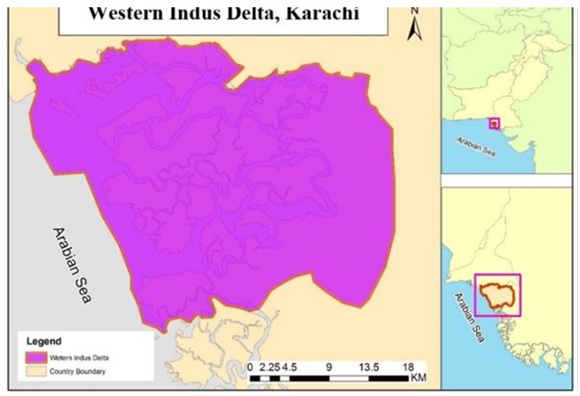Monitoring of Mangrove Cover of Western Indus Delta Karachi Pakistan
DOI:
https://doi.org/10.33411/ijist/2021030202Keywords:
mangrove, specie, arid, industrial pollution, Thematic MapperAbstract
The coastline of Pakistan comprises of five significant sites comprising of mangroves including Indus Delta which contains extensive mangroves zones and termed as the largest arid mangrove found globally. This study evaluate the current extent of mangroves along the Western edge of Indus Delta and provide the most recent forest cover assessment of mangroves. Moreover, this study identifies the changes occurred in forest cover from the years 2000 to 2020. Landsat 5 Thematic Mapper (TM), 8 Operational Land Imager (OLI) and Landsat 7 ETM data were used for mangroves mapping through supervised classification method. The results displayed that total area of mangrove forest cover was nearly 279.094km², 395.77km², 306.58km² in the years 2000, 2010 and 2020 respectively. This study indicates an increase in area of mangrove cover from 29% to 41% from the year 2000 to 2010. Regeneration of mangrove mostly took place around the southern region of the Indus Delta. The mangrove specie has decreased from 41% to 31% from the year 2010 to 2020. The major causes of this reduction were urban water and industrial pollution, over-fishing in Indus delta, freshwater diversion for agriculture, and overharvesting of mangroves by the local communities, coastal erosion and sedimentation.
References
Alamgir, M. Impacts of indiscriminate disposal of untreated effluents in Korangi creek,Karachi,Pakistan. Applied Water Science, 2018.
Ahmad, F. Mangrove conservation along the coast of Sonmiani, Balochistan, Pakistan. Trees, pp: 213-217, 2002.
Ali, N. Flora of Pakistan. Botany Dept. Karachi, University of Karachi, Karachi Vanity Printing Press, 2009.
Atta, S. Fragile mangroves and increasing susceptibility to coastal hazards in pakistan. Participatory Mangrove Management in a Changing Climate, pp: 17-30, 2017.
Bhim,P. The Use and Management of Mangrove Ecosystem In Pakistan. The Journal of Environment and Development, pp: 446-467, 2010.
Chandra Giri, J. Distribution and dynamics of mangrove forests of South Asia. Journal Of Environmental Management, 2010.
Stokes, R. Addressing the mismatch between restoration objectives and monitoring needs to support mangrove management. Ocean And Coastal Management, pp:134-146, 2016.
Duke, N. Oil spill impacts on mangroves: Recommendations for operational planning and action based on a global review. Marine Pollution Bulletin, pp: 700-715, 2016.
Hesham,S. Locating suitable mangrove plantation sites along the Saudi Arabia Red Sea Coast. Journal of African Earth Science, 2013.
Masood, S. A. Application of Comparative Remote Sensing Techniques for. Biological Forum – An International Journal, Vol 7, issue 1, pp: 783-792, 2015.
Huge, j. Mapping discourses using Q methodology in Matang Mangrove Forest,. Journal of Environmental Management, pp: 988-997, 2016.
Khalil, S. THE ECONOMIC VALUATION OF MANGROVES. Pakistan economic and social review, pp: 16-46, 2009.
Luojia Hu,L. Monitoring mangrove forest change in China from 1990 to 2015 using Landsat-derived spectral-temporal variability metrics. Int J Apple Earth Obs GeoInformation, 2015.
Jayanthi,T. Spatial and temporal changes in mangrove cover across the protected and unprotected forests of India. Esturine,Coastal and Shelf Science, 2017.
Oostdijk,J. Assessing rehabilitation of managed mangrove ecosystems using high resolution remote sensing. Estuarine, Coastal and Shelf Science, 2017.
Mingming, Z. Monitoring loss and recovery of mangrove forests during 42 years: The achievements of mangrove conservation in China. Int J Appl Earth Obs Geoinformation, pp: 535-545, 2018.
Ijaz, b. Geospatial analysis of creeks evolution in the Indus Delta, Pakistan. Estuarine, Coastal and Shelf Science, pp: 324-334, 2017.
Ibrahim, N. Mapping mangrove changes in the Matang Mangrove Forest using multi temporal sattlite imageries. Ocean and coastal management, 2015.
Bano,N. Significance of bacteria in the flux of organic matter in the tidal creek of the mangrove ecosystembof the indus river delta, Pakistan. Marine Ecology Series, pp:1-12, 1997.
Duke, M. Factors influecing Biodiversity and Distributional Gradiants in Mangroves. Global Ecology and Biogeography, pp: 27-47, 1998.
Harrison, N. Nutrient and phytoplankton dynamics in mangrove tidal creeks of indus delta, Pakistan. Marine Ecology Progress Series, pp: 13-19, 2006.
Qureshi, M. Rehabilitation and management of mangrove forests of Pakistan. Towards the rational of high salinty, pp: 89-95, 2016.
Qureshi, T. Experimental Plantation for Rehabilitation of Mangrove Forest in Pakistan. Sindh Forest Department, Government of Sindh, Karachi Pakistan. pp: 86, 1988.
Rizvi, S. Status of marine pollution in the context of coastal zone Management in Pakistan. Coastal zone management imperative for Maritime Developing Nations, pp: 347-370, 2015

Published
How to Cite
Issue
Section
License
Copyright (c) 2021 50sea

This work is licensed under a Creative Commons Attribution 4.0 International License.




















